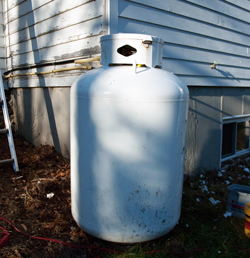In Business Since | License #
In Business Since | License #


Propane tanks come in several sizes. Choose one based upon your propane usage.
By definition, a furnace heats air which is then distributed to living areas through a ductwork system. "Supply" ducts deliver heated air, while "return" ducts bring air that has cooled back to the furnace where it can be reheated.
Most furnaces are designed to burn a specific type of fuel. A propane furnace works much the same as a natural gas furnace. Propane fuel is produced as a byproduct of natural gas and petroleum refining. About 90% of the propane consumed in the U.S. is also produced here. A great deal of propane fuel is sold in portable, refillable tanks. However, a home with a propane furnace will usually have propane fuel delivered to a larger, permanently installed tank. Propane furnaces are described in the following ways:
A propane furnace more than 10 years old can be functioning perfectly but only working at 65% efficiency. Newer propane furnaces are available that operate at 96% efficiency. Dr. Energy Saver can evaluate your current heating system and provide a free quote on a super-efficient furnace that will save you money. Call or email today for a free quote.
It's easy to tell if you have an old-style propane furnace. It will have a flue pipe that's connected to a chimney. So-called "atmospheric" or "natural combustion" furnaces can perform reliably for years. But even when operating perfectly, their AFUE numbers probably won't get above 65% - 75%.
A sealed-combustion furnace is so named because the combustion chamber is sealed in order to have more control over the combustion process. The air required for combustion is piped to the combustion chamber from outside the house, through a small-diameter plastic pipe. Gasses that result from combustion are also vented outside through a plastic pipe, with assistance from a small fan. This type of furnace is also sometimes called "direct vent" because it can be vented through an exterior wall. No chimney is necessary.
Sealed-combustion furnaces are super-efficient, earning AFUE ratings as high as 96%. Nearly all the heat potential of the fuel is extracted, making flue gasses cool enough to be vented outside through a plastic pipe. A small amount of water results during the heat condensing cycle, and this condensate is typically piped to a floor drain.
Looking for a price? Get a no cost, no obligation free estimate.